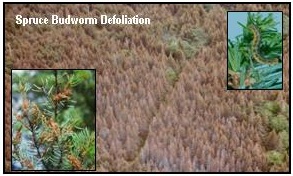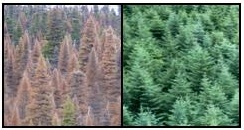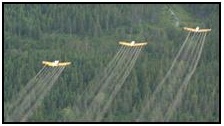Mission Statement: “The Forest Insect and Disease Control Section monitors and evaluates forest insect and disease conditions and their potential impact on the Province’s forest ecosystem, and recommends, develops, implements and evaluates preventative or control actions.”
- Control Program Information
- Forest Insect and Disease Monitoring and Control Results
- Report Forest Pests or Damage
- Further Resources
Protecting our Forests from Insects and Diseases
An essential part of good forest stewardship is the protection of our forests from uncontrolled outbreaks of major forest pests. The Forest Insect and Disease Control Section is responsible for forest pest management activities. These include:
- surveys to monitor and forecast populations of major insect and disease pests;
- examination of potential impacts; and
- the assessment and provision of control options as needed.
Outbreaks of major forest insects such as the eastern spruce budworm and eastern hemlock looper, as well as introductions of invasive or exotic species can have major impacts on our forests. Feeding damage or defoliation by these forest pests can cause widespread tree mortality and growth losses. The spruce budworm outbreak which occurred in the 1970s and 1980s, affected over 90 per cent of the Island’s forests, resulting in the loss of an estimated 50 million cubic metres of fir and spruce. This was equivalent to a 25-year supply of wood to the forest industry at that time.
Outbreaks of major forest pests can also have adverse effects on wildlife habitat and ecosystem processes, they can increase the risk of fire, and reduce forest aesthetics, recreational use and tourism. Healthy forests provide many benefits to the people of the province; they are essential to ecosystem function and biodiversity, they have provided economic opportunities, and they have sustained us, influenced our culture(s) and shaped our history. The department, in partnership with forest industry and other federal and provincial stakeholders, remains committed to forest protection and the maintenance of healthy forests through the use of an integrated pest management (IPM) approach.
IPM involves the use of a variety of tools and techniques to assess and reduce pest populations. They include new survey tools to monitor population levels, improved methods of evaluating impacts under different protection scenarios, and the development of new products and enhanced technologies to protect forest areas.
 The latter may include one or a combination of the following – biological controls such as insect specific viruses (e.g. Abietiv for balsam fir sawfly), rearing and release of insect parasitoids/ predators, the application of sex pheromones to disrupt mating, the use of enhanced aerial application technologies, and the use of pesticides registered for use against specific pests. Since 1977, the biological insecticide B.t.k., a naturally occurring bacterium, has been aerially applied to protect forest areas from high populations of spruce budworm and hemlock looper. Silviculture techniques such as modifying the species composition of forest stands to reduce their vulnerability to damage and salvaging of impacted areas is also used.
The latter may include one or a combination of the following – biological controls such as insect specific viruses (e.g. Abietiv for balsam fir sawfly), rearing and release of insect parasitoids/ predators, the application of sex pheromones to disrupt mating, the use of enhanced aerial application technologies, and the use of pesticides registered for use against specific pests. Since 1977, the biological insecticide B.t.k., a naturally occurring bacterium, has been aerially applied to protect forest areas from high populations of spruce budworm and hemlock looper. Silviculture techniques such as modifying the species composition of forest stands to reduce their vulnerability to damage and salvaging of impacted areas is also used.
Managing forest pests at times can be complex, however, the department remains committed to using the most effective and efficient protection options available, while meeting all health and environmental guidelines as set out by Health Canada and the Department of Environment and Climate Change, with preference given to biological control options when available and cost effective. To prevent or control impacts caused by both native and invasive forest pests will ultimately require the collective efforts of many individuals – we all share a role in the protection of our forest resources and in maintaining healthy forest ecosystems.
Report Forest Pests or Damage
To report forest pest populations or damage, or for additional information on forest pest management, contact the Forest Insect and Disease Program.
